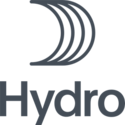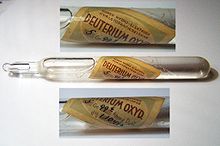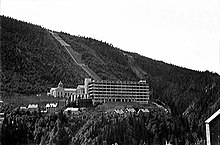Norsk Hydro
| Norsk Hydro ASA
|
|
|---|---|
| legal form | Allmennaksjeselskap |
| ISIN | NO0005052605 |
| founding | 1905 |
| Seat | Oslo , Norway |
| management | Hilde Merete Aasheim |
| Number of employees | 34,625 |
| sales | 109.22 billion NOK 11.09 billion EUR |
| Branch | aluminum |
| Website | www.hydro.com |
| As of December 31, 2017 | |
Norsk Hydro ASA is an international aluminum producer based in Oslo . The company is listed in the OBX index .
Core business
Since the spin-off of the Petroleum & Energy division on October 1, 2007 (which merged with the Statoil Group to form StatoilHydro ), Hydro has been concentrating on its aluminum business. In 2013, Hydro is one of the largest aluminum producers in the world. 2002 Hydro acquired the leading German aluminum producer VAW from German utilities E.ON . In October, Norsk Hydro bought the subsidiary SAPA, in which 50% of the shares had previously been held. Norsk Hydro has business activities in 40 countries around the world, on every continent. The Norwegian state holds 34.3 percent of the company's shares. The group now employs around 34,600 people (as of 2017). The chairwoman of the board has been Hilde Merete Aasheim since May 8, 2019 .
history
The company was founded by Sam Eyde and Kristian Birkeland on December 2nd, 1905 to commercially exploit a new technology developed by Birkeland for the production of mineral fertilizers by binding atmospheric nitrogen . Hydro's first factory was in Notodden , followed by another in Rjukan .
From around 1929 Norsk Hydro used the Haber-Bosch process for the production of nitrogen fertilizers , which has clear advantages over the Birkeland-Eyde process.
For the production facilities in Rjukan, the hydrogen required for the Haber-Bosch process in large quantities was available from the newly built factory at the Vemork power station from 1934 . The factory produced hydrogen by electrolysis of water and required a lot of electrical energy to do this. In order to keep the energy losses as low as possible, the hydrogen electrolysis was built right next to the power plant. The hydrogen produced was transported to the plants in Rjukan via a pipeline.
Heavy water is produced as a by-product of water electrolysis , which means that the hydrogen factory in Vemork was the only production site for highly concentrated heavy water in Europe at the time. After the occupation of Norway by the German occupying forces in April 1940, the production of the heavy water that was supposed to benefit the uranium project was pushed ahead. The factory became the target of one of the most spectacular resistance actions of the Second World War when twelve Norwegians trained in England succeeded on February 27, 1943 in blowing up large parts of the plant. These events provided the background for the English feature film Keyword “Schweres Wasser” ( The Heroes of Telemark , 1965) and the Norwegian TV miniseries Saboteurs im Eis ( Kampen om tungtvannet , 2015). Knut Haugland , who became known for the Kon-Tiki expedition in 1947, was also involved in the attack . The rapid reconstruction was followed by bombing raids by the Allies.
For the 100th anniversary of Norsk Hydro in 2005, a three-volume company history was published, elaborated by independent historians, which, among other things, critically questions the intensive cooperation with the German occupying power . In the summer of 1943 , the company employed around 1,000 forced laborers and 300 Yugoslav and Soviet prisoners of war at the Porsgrunn plant . The factory facilities were temporarily guarded by Norwegian SS soldiers. Hydro also worked closely with the German chemical company IG Farben .
At the beginning of the 1970s, the company was guilty of massive environmental pollution , especially in the vicinity of the Porsgrunn site . It was not until 1974 that the situation eased due to new legal regulations. Nonetheless, Norsk Hydro was the target of protests by environmentalists on several occasions in the 1980s .
In 1999, Norsk Hydro acquired the Norwegian oil and gas producer Saga Petroleum . Hydros fertilizer business, which was bundled in the subsidiary Hydro Agri , was transferred to the listed Yara International on March 26, 2004 , with production facilities and a. in Brunsbüttel , Rostock , Porsgrunn and Glomfjord . Norsk Hydro sold its Yara shares to Hydro shareholders and no longer holds any shares in Yara.
Norsk Hydro was the second largest oil and gas producer on the Norwegian continental shelf until the oil and energy division was split off . This merged on October 1, 2007 with the Norwegian Statoil group. Since then, Norsk Hydro has continued to operate as a pure aluminum company. In 2002, Norsk Hydro acquired VAW Aluminum from E.ON for EUR 3.1 billion .
In 2009 the company sold its Automotive Structures division with around 1,200 employees and a turnover of around 260 million euros to the Paderborn-based automotive supplier Benteler Automobiltechnik GmbH.
In October 2017, Norsk Hydro took over all shares in the previous 50/50 joint venture Sapa AS from partner Orkla ASA .
On March 18, 2019, Norsk Hydro became the victim of a large-scale cyberattack , which resulted in production facilities only being able to be operated manually. The company's website was also shut down and Norsk Hydro released information to the public via Facebook messages.
Environmental damage in the Brazilian rainforest 2018
In February 2018, parts of the Amazon region around Para were flooded with toxic red mud from the aluminum works Hydro AluNorte and Albras after heavy rainfall. The plants in the Barcarena region, around 15 kilometers from the city of Belem at the mouth of the Amazon River, are operated by Alumínio Brasileiro , a Brazilian partner of Hydro Norsk, and half are owned by Norwegians. On March 20, 2018, Hydro Norsk admitted that it had discharged contaminated untreated water into a river. The company first rejected this fact. The company's then president, Svein Richard Brandtzæg, said that untreated water had been dumped into the Para River from the sumps and apologized for the action. He announced an internal investigation for which the company plans to invest 52.6 million euros. As a result of the incident, the AluNorte plant - which it claims to be the largest aluminum oxide refinery in the world - was ordered by the court to reduce its production by 50%.
In the mud of the overflowing red mud basins, local authorities found not only bauxite in rivers in the region but also aluminum residues, phosphorus, fluoride and nitrate in high concentrations. 5,000 people live near the basins; many complained of nausea, itchy skin, and diarrhea.
Joint ventures
- Alumínio Brasileiro : Joint venture between Norsk Hydro and Nippon Amazon Aluminum Co. Ltd. (NAAC)
- Qatar Aluminum : Joint venture between Qatar Petroleum and Hydro Aluminum AS , a subsidiary of Norsk Hydro.
- Aluminum Norf : Joint venture between Novelis and Hydro Aluminum AS , a subsidiary of Norsk Hydro. AluNorf, based in the Norf district of Neuss, is the largest aluminum rolling mill in the world with an average rolling capacity of 1.5 million tons of aluminum per year.
See also
literature
- Ketil Gjølme Andersen (inter alia), 'Hydros historie 1905-2005', 3 vols., Oslo: Pax, 2005 ISBN 82-530-2835-0 .
- Hasso Grabner, 'Secret Files Norsk Hydro', German Military Publishing House Berlin, 1966 without ISBN
Web links
Individual evidence
- ↑ a b Norsk Hydro 2017 Annual Report , accessed October 13, 2018
- ↑ Converted at the rate on the balance sheet date, December 31, 2017
- ↑ world-aluminium.org: The Global Aluminum Industry - 40 years from 1972
- ↑ information shareholder , on www.hydro.com , accessed on 13 October 2018
- ↑ New CEO focused on increasing profitability and promoting sustainability. Norsk Hydro, May 8, 2019, accessed May 12, 2019 .
- ↑ https://www.eon.com/de/presse/news/pressemitteilungen/2002/1/7/e-dot-on-verkauf-vaw-aluminium-an-norsk-hydro.html
- ↑ Hydro sells Automotive Structures to Benteler, notification of October 27, 2009
- ↑ Norsk Hydro - The acquisition of Sapa is complete , on www.hydro.com , accessed October 13, 2018
- ↑ Huge aluminum plants hit by cyber-attack. BBC News, March 19, 2019, accessed March 19, 2019 .
- ↑ a b Environmental scandal in Brazil - Norsk Hydro acknowledges responsibility . In: Deutschlandfunk . ( deutschlandfunk.de [accessed on March 26, 2018]).
- ↑ Environmental scandal in Brazil - Norsk Hydro acknowledges responsibility . In: Deutschlandfunk . ( deutschlandfunk.de [accessed on March 26, 2018]).
- ↑ https://www.reuters.com/article/norsk-hydro-brazil/update-1-brazil-federal-court-upholds-output-cut-at-norsk-hydros-alunorte-idUSL1N1S81NG



